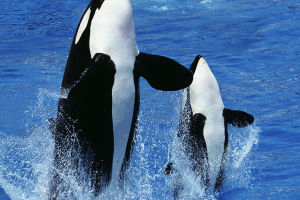Orcas are formidable predators in the ocean. With their fierce nature and strong attack power, even sharks fear them. However, when it comes to interactions with humans, they generally exhibit friendliness and do not actively seek to harm them.
The original ancestor of the killer whale actually lived on land. It had four long legs, sharp canine teeth, and two large ears. About the size of a dog, it struggled to compete with other land predators, prompting its return to the ocean, the birthplace of life.
After more than 5,000 years of evolution, this creature transformed into the dominant force of the seas.
So, who is stronger: the killer whale or the great white shark?
The orca's brain weighs 500 grams, while the great white shark's brain is only 20 grams. The orca's brain features much more complex grooves, giving it a clear intellectual advantage over the great white shark.
In terms of physical size, orcas can grow over 8 meters in length and weigh up to 5.5 tons, surpassing the maximum size of a great white shark, which is around 6.5 meters and weighs up to 1.8 tons.
Thus, when encountered, great white sharks are destined to be quickly overpowered by orcas.
Orcas have a unique appearance, often described as nerdy. However, as for marine creatures, they are a source of terror. These intelligent mammals prefer to hunt in groups, working together as a team.
They surround their prey, taking turns to feast on the captured fish. While they primarily feed on various fish species, orcas have been known to target other whales, including humpback whales, fin whales, and even the enormous blue whales.
In a shocking incident captured by a foreign photographer in 2021, a 15-meter-long adult blue whale mistakenly entered an orca enclosure and was torn apart by 72 orcas.
Orcas possess a rich language and communication system. Underwater, they utilize ultrasound to communicate with their companions, with sounds traveling long distances.
Biologists have discovered that different orca colonies have unique dialects, with one Icelandic colony exhibiting 24 distinct calls. When in a joyful mood, orcas even whistle.
Wild orcas have been observed to display friendliness towards humans, sometimes following them in boats and even allowing humans to pet them by poking their heads out of the water.
Scientists speculate that orcas recognize humans' lung-like breathing patterns through their sonar system, leading them to consider humans as their own kind. Additionally, humans may appear endearing in the eyes of orcas.
Experts also propose that orcas have witnessed the power of humans, which deters them from causing harm. orcas are highly social and possess strong memories.
Some individuals may have observed past encounters between humans and orcas, witnessing the ruthlessness of humans, including conflicts among their own species.
Humans can construct large ships, which, in the eyes of orcas, gives them control over oceanic giants, thus invoking a sense of reverence.
Other biologists theorize that in ancient times, the relationship between human ancestors and orca ancestors was similar to our bond with canines.
Over time, this connection may have faded, although traces remain, explaining the friendly behavior of orcas towards humans.
These analyses hold some truth and are not baseless, given that orcas have an IQ comparable to that of a 10-year-old child, with a strong ability to comprehend.
Moreover, orcas are highly vocal and engage in family chats when not hunting, allowing older orcas to pass down their impressions of humans to younger generations.


